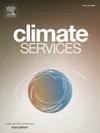Contextual drivers of climate-smart agroforestry adoption in Bugesera and Rulindo agroecosystems of Rwanda
IF 4
3区 环境科学与生态学
Q2 ENVIRONMENTAL SCIENCES
引用次数: 0
Abstract
This study examined 381 farmers from two regions in Rwanda to investigate how contextual factors at the field level interact with climate-smart agroforestry (CSAF) practices. Farmers were categorized as low (LAD), medium (MAD), and high (HAD) adopters based on tree counts. Various contextual factors — notably location, demographics, assets, farm characteristics, and institutional variables — were analyzed using descriptive statistics, Pearson correlation, logit regression, and propensity score matching. Farmers in Bugesera had larger farms and higher tree counts than those in Rulindo, resulting in greater farm income in Bugesera. Positive correlations were found among altitude, slope, erosion class, gender, household size, poverty level, income source, marital status, education, farm area, cropping practices, farm-river distance, changes in CSAF cover, population dynamics, and LAD. CSAF farms outperformed monoculture farms regarding cassava, maize, and bean yields, particularly in Bugesera and Rulindo among larger landholdings. Logit regression analysis showed that combinations of multipurpose trees and crop planting significantly improved farm yields, with household size and farm size being critical factors for CSAF adoption. Propensity score matching confirmed the positive effects of CSAF practices on farm yield and income, contributing to enhanced rural well-being. These findings underscore the crucial role of CSAF in promoting well-being. The results encourage stakeholders to develop strategies for CSAF. While these findings are specific to local contexts, they may hold potential relevance at regional and global levels. This evidence supports the development of government-led policies implemented through extension services to systematize and stabilize CSAF practices across diverse farming systems.
卢旺达布格塞拉和鲁林多农业生态系统采用气候智能型农林业的背景驱动因素
本研究调查了来自卢旺达两个地区的381名农民,以调查田间水平的环境因素如何与气候智能型农林业(CSAF)实践相互作用。根据树木数量将农民分为低(LAD)、中(MAD)和高(HAD)采用者。使用描述性统计、Pearson相关性、logit回归和倾向评分匹配分析了各种背景因素,特别是地理位置、人口统计、资产、农场特征和制度变量。Bugesera的农民比Rulindo的农民拥有更大的农场和更高的树木数量,因此Bugesera的农业收入更高。海拔高度、坡度、侵蚀类型、性别、家庭规模、贫困程度、收入来源、婚姻状况、教育程度、农田面积、耕作方式、农田与河流距离、土壤土壤覆盖度变化、人口动态和土壤侵蚀水平呈正相关。CSAF农场在木薯、玉米和豆类产量方面优于单一种植农场,特别是在Bugesera和Rulindo的大型土地中。Logit回归分析表明,多用途树木与作物种植组合显著提高了农业产量,家庭规模和农场规模是影响农用农用作物采用的关键因素。倾向得分匹配证实了CSAF实践对农业产量和收入的积极影响,有助于提高农村福祉。这些发现强调了CSAF在促进幸福感方面的关键作用。研究结果鼓励利益相关者制定CSAF战略。虽然这些发现是针对当地情况的,但它们可能在区域和全球层面具有潜在的相关性。这一证据支持制定政府主导的政策,通过推广服务实施,使不同农业系统的CSAF实践系统化和稳定化。
本文章由计算机程序翻译,如有差异,请以英文原文为准。
求助全文
约1分钟内获得全文
求助全文
来源期刊

Climate Services
Multiple-
CiteScore
5.30
自引率
15.60%
发文量
62
期刊介绍:
The journal Climate Services publishes research with a focus on science-based and user-specific climate information underpinning climate services, ultimately to assist society to adapt to climate change. Climate Services brings science and practice closer together. The journal addresses both researchers in the field of climate service research, and stakeholders and practitioners interested in or already applying climate services. It serves as a means of communication, dialogue and exchange between researchers and stakeholders. Climate services pioneers novel research areas that directly refer to how climate information can be applied in methodologies and tools for adaptation to climate change. It publishes best practice examples, case studies as well as theories, methods and data analysis with a clear connection to climate services. The focus of the published work is often multi-disciplinary, case-specific, tailored to specific sectors and strongly application-oriented. To offer a suitable outlet for such studies, Climate Services journal introduced a new section in the research article type. The research article contains a classical scientific part as well as a section with easily understandable practical implications for policy makers and practitioners. The journal''s focus is on the use and usability of climate information for adaptation purposes underpinning climate services.
 求助内容:
求助内容: 应助结果提醒方式:
应助结果提醒方式:


